Art World
An Artist Returns to Puerto Rico to Disappear
After 40 years in New York, Papo Colo returned to Puerto Rico for the performance of his life.
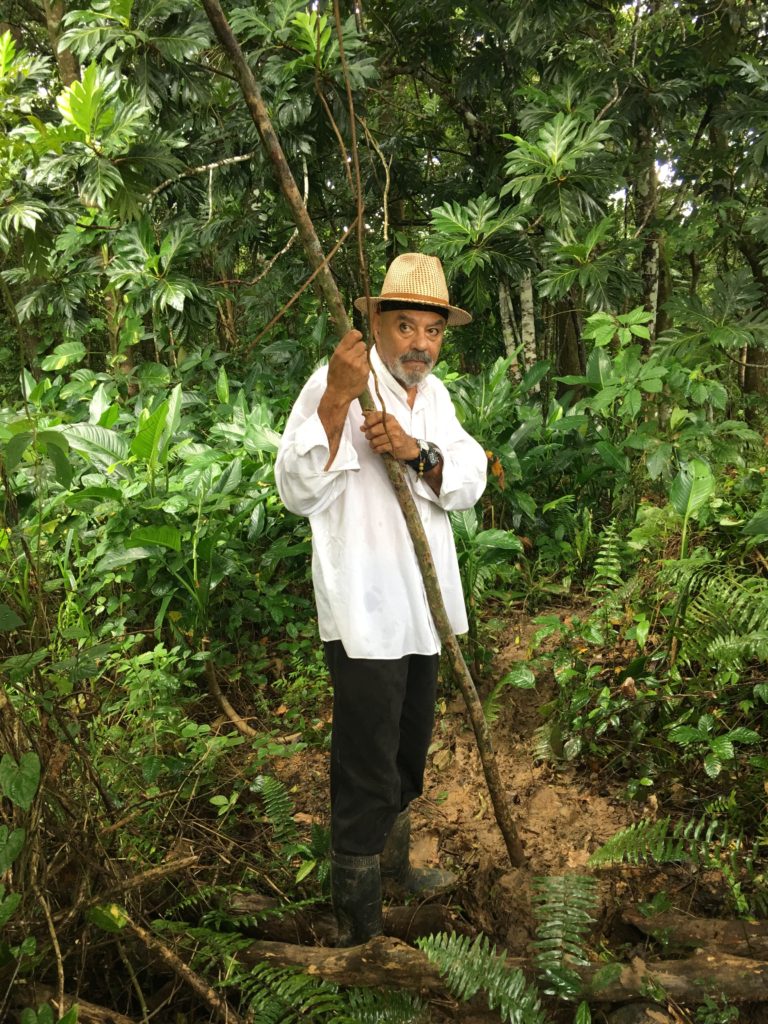
After 40 years in New York, Papo Colo returned to Puerto Rico for the performance of his life.

Rozalia Jovanovic

It was 4 o’clock on January 7 and the artist Papo Colo was nowhere to be seen. There were a few hundred people milling around a clearing in the middle of Puerto Rico’s El Yunque, the only tropical rainforest in the national Forest System, waiting for Colo, whose performance, in which he would lead them through the rainforest, was supposed to have started an hour before. Along with international art patrons, collectors, and curators, who had flown in for the event, there were two oxen, a goat, some horses, and a pig ready to begin a two-and-a-half-hour procession. But the man leading the walk, a work meant to convey the experience of migration, was thus far a no-show.
Klaus Biesenbach, the director of MoMA PS1 and the curator of the performance, titled Procesión Migración, took the goat by the leash, burst through the gate, and started the procession, Colo or no Colo. The oxen, the pig, and the horses, which pulled a carriage full of people, slowly began their descent. Colo ultimately appeared, like a Shaman, in a white flowy shirt, loose black pants, and a thin tree trunk for a walking stick to lead the crowd. “He calls himself a trickster,” Biesenbach would later say.
A disappearance of some sort was always part of the plan—for the final act of his performance, Colo would step into the Rio Espiritu Santo, take a ritual cleanse, and then walk into the shady majesty of the tabonuco trees. There, in the rainforest, he plans to live for a year without speaking.
“It’s the reconstruction of myths,” Colo said standing on the road, Carretera 186, his dark eyes gleaming exuding warmth, excitement, and the sense that I’d pulled him out of a daydream he was still partly inhabiting. “It’s about the Mystifarian: people who deal with myth and change myth.”
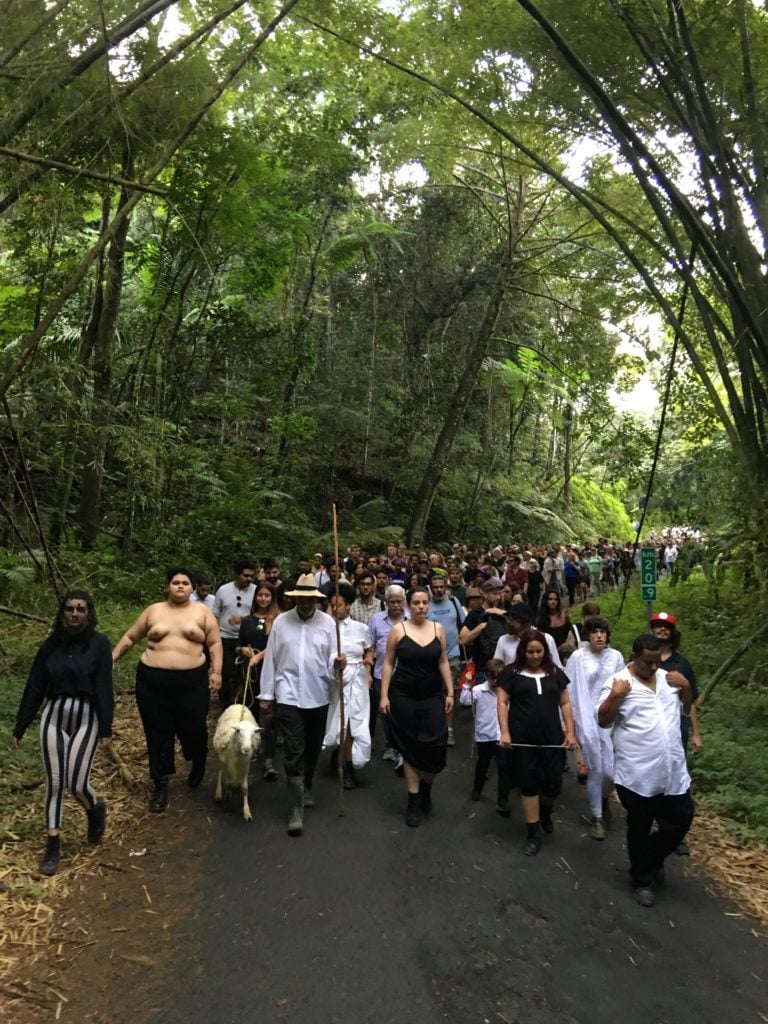
Papo Colo, Procesion Migracion (2017). Image courtesy of Klaus Biesenbach.
Though enigmatic, his words somehow embodied the spirit of this event, which, however vague in its promise for the participants (no one was quite sure what to expect), had attracted masses of locals (500 people ultimately joined in, many of whom were hip local art students, curators, and gallerists in the bustling local art scene) as well as members of the global art world, including MoMA PS1 board chairman Agnes Gund, Diana Picasso, curator Stuart Comer, Clocktower Productions director Alanna Heiss, artist duo Allora & Calzadilla, collectors Poju and Anita Zabludowicz, and their daughter Tiffany, who was a co-organizer of the event.
Colo, who is 70 years old, is perhaps best known for Exit Art, the alternative art space in New York, which he founded in 1982 with his partner Jeanette Ingberman and ran for 30 years. (In 2012, after Ingberman died of Leukemia, Colo closed the space.) But having been born in Puerto Rico and chosen the US as his home, he always fashioned himself a cultural hybrid. “The state of being a cultural hybrid,” he wrote in an essay that was read before the start of Procesión Migración, “makes you see the accumulation of transplanted history three-dimensionally.”
Feeling at times marginalized by institutions in New York because of his nationality, he made cultural identity and the struggles associated with it a point of reference for his work.
In 1977, a year after Puerto Rico’s failed bid for statehood, Colo tethered 51 pieces of white wood to his body with rope and dragged them along the West Side Highway in New York until he passed out (Superman 51). That was his first performance in New York. Several years later, he paddled up the Bronx River in a canoe through trash and debris as a comment on the effort by Puerto Ricans to assert their identity, both economically and socially (Against the Current (1983)). Like these performances, Colo staged scenarios that often pitted him in futile struggle against a system that guaranteed his failure. More recently, for Cleaner (2016), an action that coincided with a solo show of his early work at MoMA PS1 this past summer, he mopped a sidewalk in Chelsea, placed 50-dollar coins on the pavement, and cleaned them piece by piece as a comment on money laundering in tax havens in Latin America, and the stereotype of Latinos employed as cleaners.
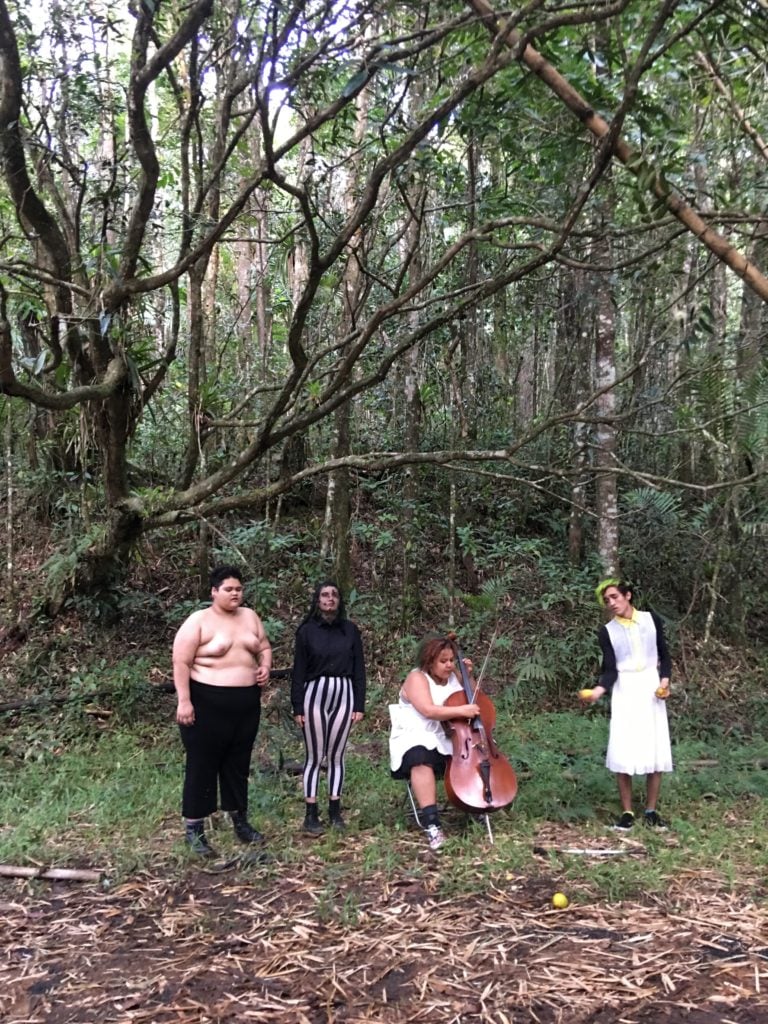
Papo Colo, Procesion Migracion (2017). Image courtesy of Klaus Biesenbach.
“There’s no such thing as a pretty Puerto Rican artist,” said Alanna Heiss, during a panel at the Liga de Arte where there was a show of Colo’s early drawings curated by Beatrice Johnson. Heiss, who founded PS1 in 1976 and was a pioneer in the alternative art space movement, has known Colo since the 70s when they were compatriots in the challenge against conventional notions of art-making. “They’re furious,” she said. “They’re cultural terrorists, revolutionaries. Activists.”
The procession through the rain forest was a final act of sorts for Colo, capping 40 years of performances, videos, actions, and sculpture, that began with that first performance in New York. But like much of his work, this one too uses his body as a symbol for so much more.
“Last summer we saw all these images of highways in Europe, completely filled with migrants walking in the roadways,” said Biesenbach. “I asked Colo, ‘Did you see these images?’ He said, ‘This happens every day with a suitcase at the airport in San Juan.’” In an effort to bring Colo’s vision to fruition, Biesenbach organized a festival, called Puertos Ricos: A Festival of Arts and Natures that started with the singing of the National Anthem in Old San Juan (by Eduardo Alegria), and continued with gallery tours, studio visits, exhibitions, and a hike to an installation called Puerto Rican Light by art duo Allora & Calzadilla in a cave near Ponce.
The procession, which was supported by MoMA PS1 and the Museo de Arte de Ponce, was also meant to get people thinking about various forms of migration, of particular relevance to Puerto Ricans.
After World War II, a series of economical projects transformed Puerto Rico’s economy from an agrarian system to an industrial one, producing a wave of immigration in the 1950s, 60s, and 70s. And while the island used to be a tax haven for pharmaceutical companies, the tax incentives were rolled back in the 1990s (fully ending in 2006) causing an economic collapse that the island has yet to recover from, which has spurred a mass exodus not seen since the 50s.
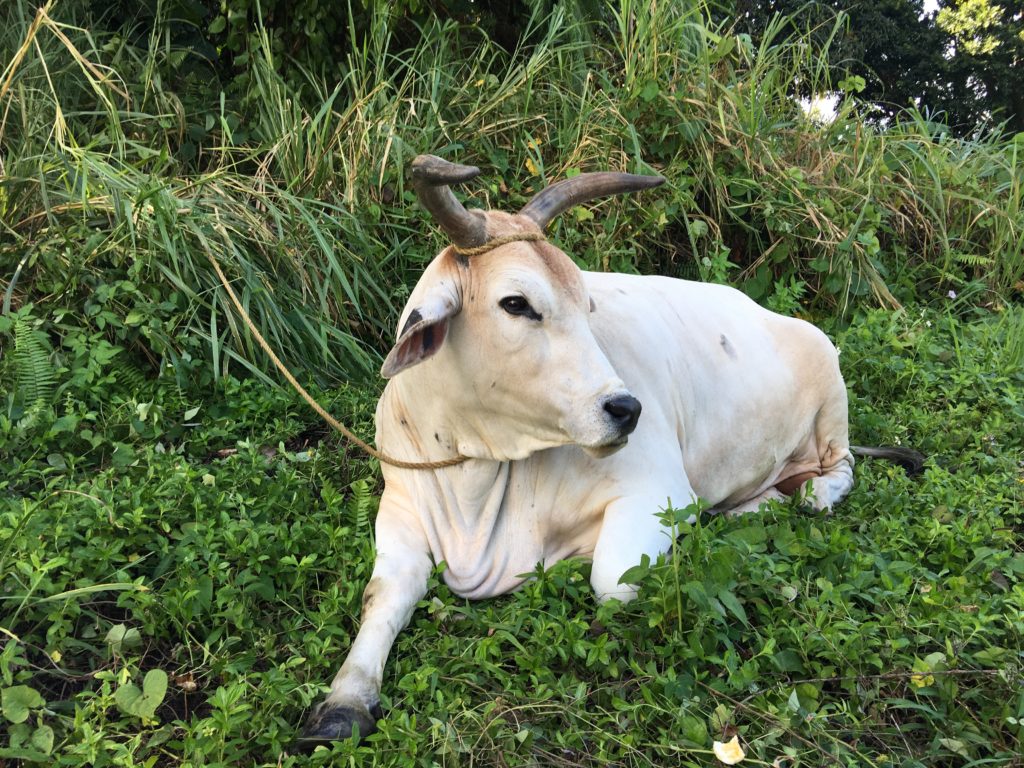
Papo Colo, Procesion Migracion (2017). Image courtesy of Klaus Biesenbach.
“Jennifer [Allora] and Guillermo [Calzadilla] started telling me how many of their relatives were leaving the island,” said Biesenbach about how he first learned of the situation in Puerto Rico. “I was made aware by them about the severe debt crisis, the decade-long recession, the lack of prospects for so many on the island, and what kind of state Puerto Rico is really in.”
As we began our trek, which required permissions from the Puerto Rico Highway and Transportation Authority, the US National Park Service, and the local police, in order to close off Carretera 186, we passed numerous dreamy tableaux vivants: one featured two women who moved slowly toward each other on a bridge with a small waterfall gushing nearby; in another, two transvestites kissed passionately behind a tree; and, in a third, a tall beautiful woman held a chicken and moved it as if delineating the points of a cross (a reference to Santeria, which is practiced on the island).
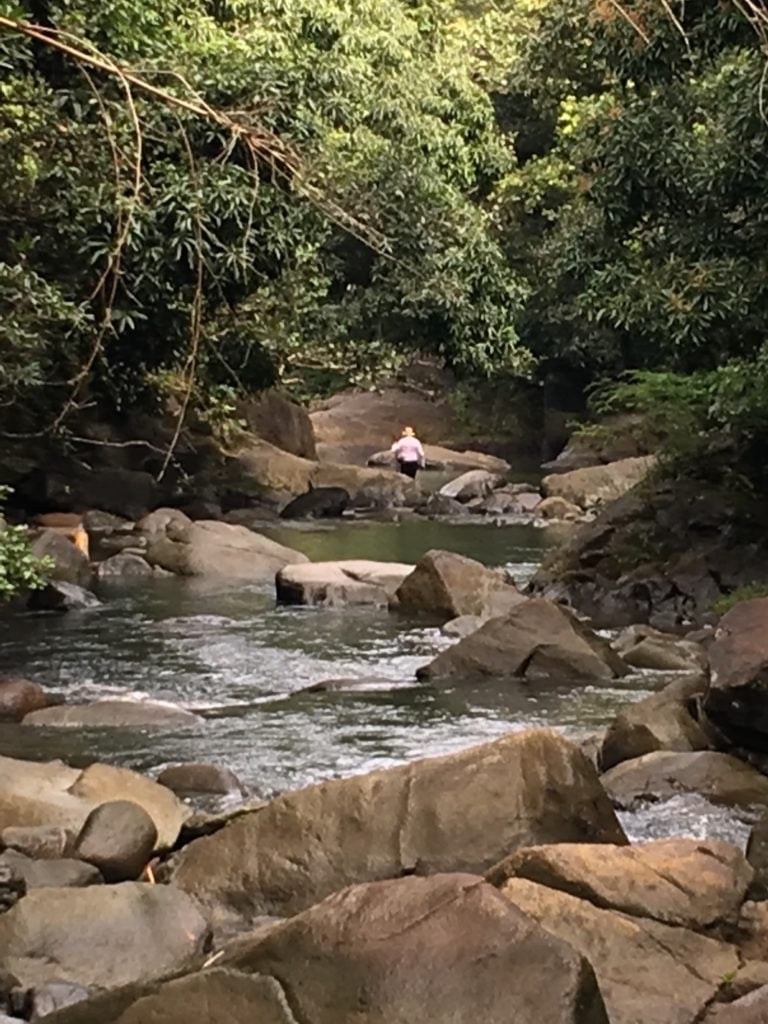
Papo Colo, Procesion Migracion (2017). Image courtesy of Klaus Biesenbach.
The performances seemed secondary to the sheer arduousness of walking for miles with hundreds of people, some of whom carried luggage (per direction), some of whom sang, and some of whom I befriended on the walk. The road got muddy at various points, and the horses, pigs, and oxcarts sometimes veered into my path. But after two hours, people walked mostly in silence, seemingly unified, both mentally and in movement. Colo walked in front, guiding us without saying barely a word, stopping from time to time to indicate the presence of a tableau. Somehow the swarm of people paused with him, with an intelligence all its own, and took in the performances.
“When it’s two-and-a-half hours,” said Biesenbach days later over the phone, “it’s difficult to escape the idea of presence.”
For the followers, the journey ended at Papo Colo’s foundation set in a modernist structure in the northeast of the rain forest, where he would remain for the year. There, the group thinned out into a line and descended the banks of the Rio Espiritu Santo to watch Colo and the other actors engage in a ritual cleansing before his departure.
“That was like the sleep after sex,” said one viewer.
Earlier in the day, when Colo had finally arrived to lead the journey and was standing by the side of the road surveying the scene, as if imagining the Procesión Migración on a larger scale, he said, “It’s going to be local, national, and international. What happens in migration, happens to us all the time.”
I asked Colo, who officially stopped speaking on Monday, how he felt that day. He looked around as if searching for the right word. “Sexy,” he said. “I feel sexy.” With that, he walked toward the crowd and blended in.